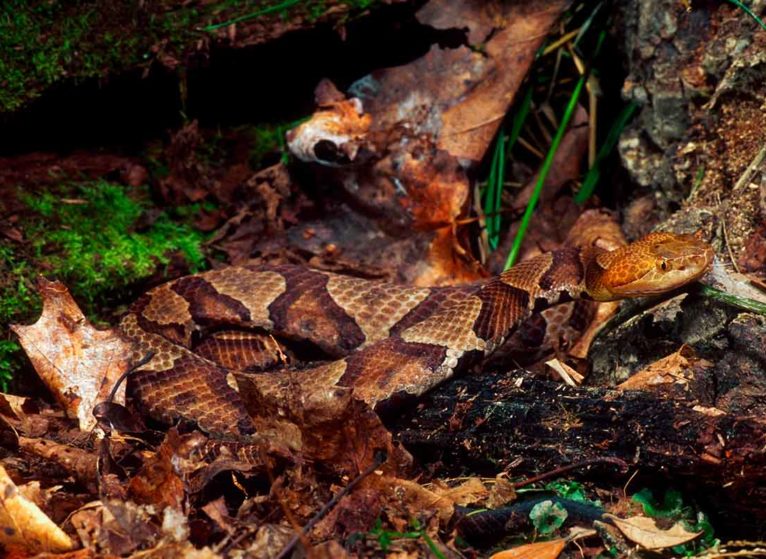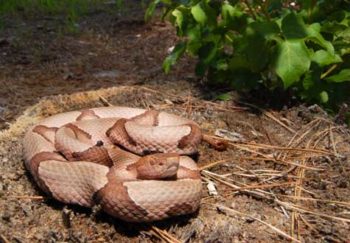My mom wanted me to avoid the woods behind our house in Virginia Beach. So she warned me repeatedly about water moccasins (also known as cottonmouths). Growing up, I believed that these venomous snakes would chase me through the woods and bite me, and I’d be dead within seconds.
Years later, while hiking together and seeing many water moccasins, Mom admitted that she’d been trying to scare me. The snakes just ignored us or slithered away from the sound of our voices — after all, we were way larger and quite capable of hurting them. I realized as long as I kept my eyes on the ground and didn’t try to pick them up, my chances of a bite were almost nothing.
Myths vs. Facts: Venomous Snakes & Snakebites
I know plenty of adults who are more afraid of snakes than anything. They kill every snake they see — which might actually put them in more danger. If even just thinking about snakes makes your heart race, learning the facts can help you co-exist peacefully with these reptiles.
Christopher Holstege, MD, directs the Blue Ridge Poison Center (BRPC), which is part of UVA Health. The BRPC addresses poison concerns for much of central and western Virginia. Holstege helped address some common snake and snakebite myths and questions.
There are more snakebites in Virginia this year.
Fact. The BRPC has already received 24 calls about snake bites in 2025 — and June just started. Nationwide, about 3,000 venomous snake bites get reported to U.S. poison centers each year.
Most snakebites come from someone trying to catch or kill the snake.
Partly fact. You’ll probably get bitten if you try to pick up a venomous snake. Otherwise, snakes try to hide or escape and only bite as a last resort.
The BRPC sees bites from hikers, gardeners, and others who accidentally get too close. To reduce your chances of a bite:
- Use a flashlight if you’re walking outdoors after dark.
- Wear long pants and shoes when in snake habitats, such as tall grass, rocky areas, or the forest.
- Watch where you put your hands and feet.
If you get bitten, you should kill the snake and bring it to the hospital with you so doctors can identify it.
Myth. If you can safely and quickly take a photo, that’s fine. But Holstege says doctors use the same antivenom for all North American snakes, except the coral snake, which doesn't reside in Virginia. They don’t need to know what bit you.
Plus, if you try to kill the snake, you may get bitten again. And you’re wasting time — you need to get to the emergency department.
You can suck the poison out of a snakebite.
Myth. Studies show that this doesn’t work, Holstege says. Plus, putting suction on damaged skin can do more damage.
These home remedies also don’t work and can cause more harm:
- Tourniquets
- Cutting the wound
- Ice
There’s nothing you can do at home to limit the damage from snake venom. Go to the nearest emergency department, quickly.
Many venomous snakebites are fatal.
Partly fact, but not in the U.S. Depending on the snake and the amount of venom it injects, you may need:
- Antivenom
- A hospital stay
- Physical therapy
But if you go to the hospital soon after the bite, you’ll almost surely make a full recovery.
That’s harder in other parts of the world, where lack of access to healthcare makes snakebites a public health crisis. According to the World Health Organization, “There are between 81,410-137,880 deaths and around three times as many amputations and other permanent disabilities each year.”
Most snakes are venomous.
Myth. Virginia has 30 native snake species, according to the Wildlife Center of Virginia. Only three are venomous — cottonmouths, copperheads, and timber rattlesnakes.
All swimming snakes are venomous water moccasins.
Myth. All snakes swim, and people often confuse nonvenomous water snakes for water moccasins. But these snakes are nowhere near us, according to the Virginia Herpetological Society. They stay in the southeastern part of the state.
The only two venomous snakes in our area are copperheads and timber rattlesnakes. The BRPC mostly sees copperhead bites. Timber rattlesnakes avoid densely populated areas, like the city of Charlottesville.
Mothballs keep snakes away.
Myth. Mothballs don’t keep snakes away. Plus, they can poison kids, pets, and other animals. Products advertised as snake repellents also don’t work.
Poison Concerns?
Poison centers offer free, confidential advice about snakebites, overdoses, and other suspected poisonings.
It’s safer to just kill any snake you see, especially if it’s in your yard.
Myth. Your fear is understandable, especially if you have kids or pets. But the more you engage with the snake, the more likely you are to get bitten.
Having non-venomous snakes around can be a good thing, Holstege notes: They kill the venomous ones, or at least keep them away.
But to avoid an unwelcome encounter in your yard or house, try these recommendations from the Virginia Department of Wildlife:
- Remove areas that provide cover and shelter for snakes, including piles of logs or trash.
- Keep grass and other vegetation mowed or trimmed.
- Make sure your screens and doors close tightly.
- Seal cracks and holes in your crawl space or basement.
- Check your roof for overhanging vegetation. Snakes can climb trees and enter your attic.
- Keep your house rodent-free.
This post was updated June 5, 2025.


